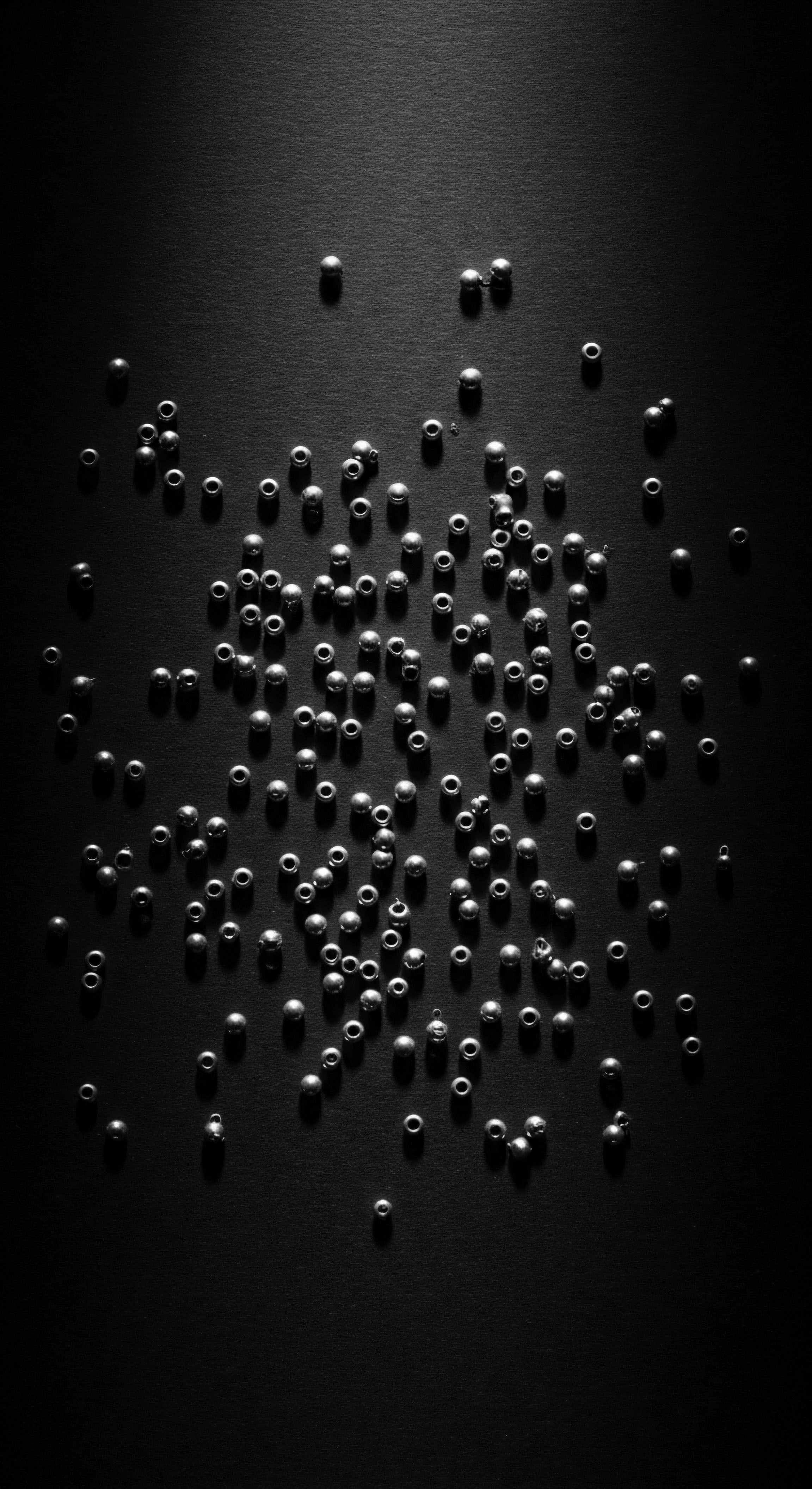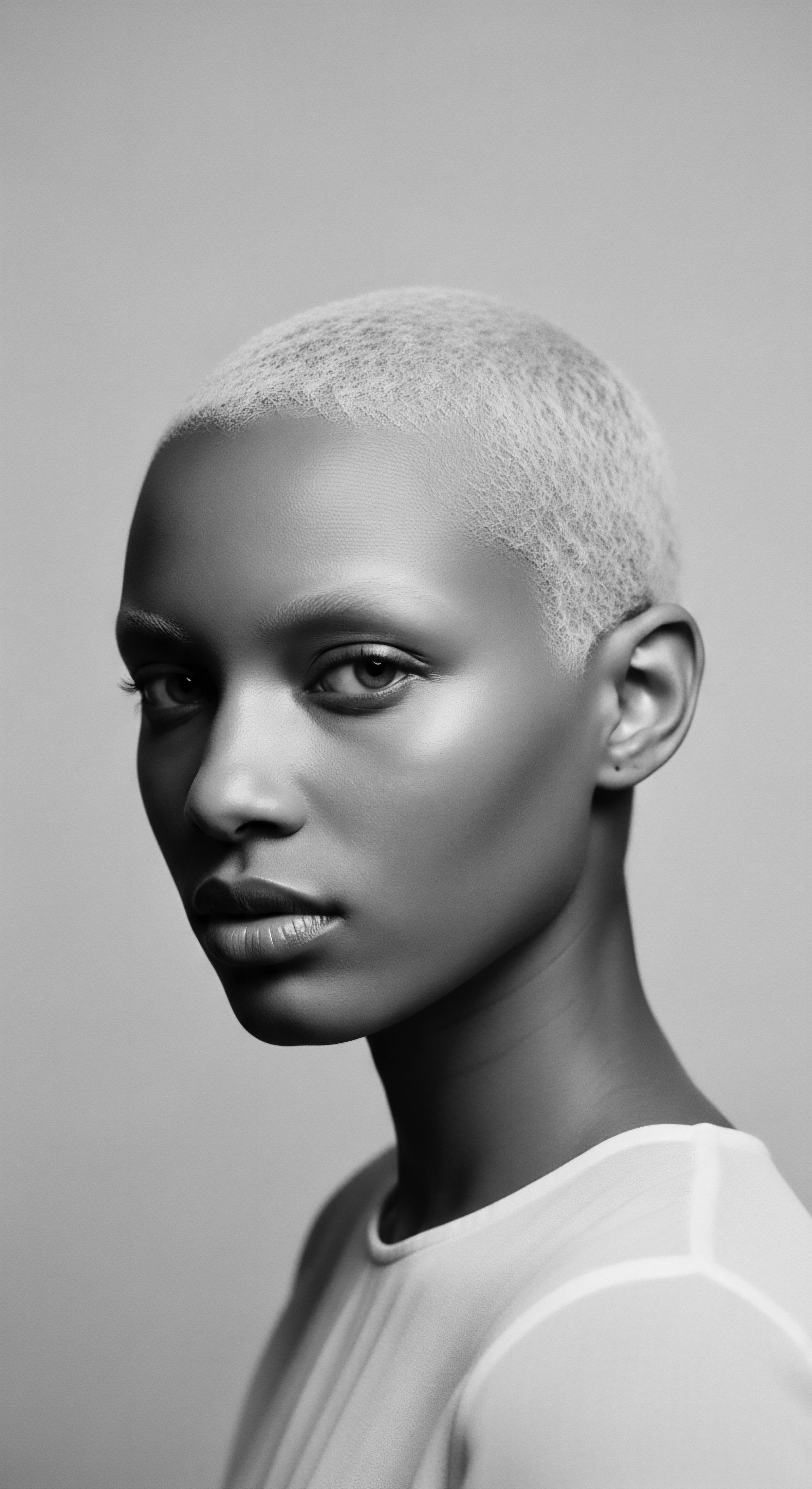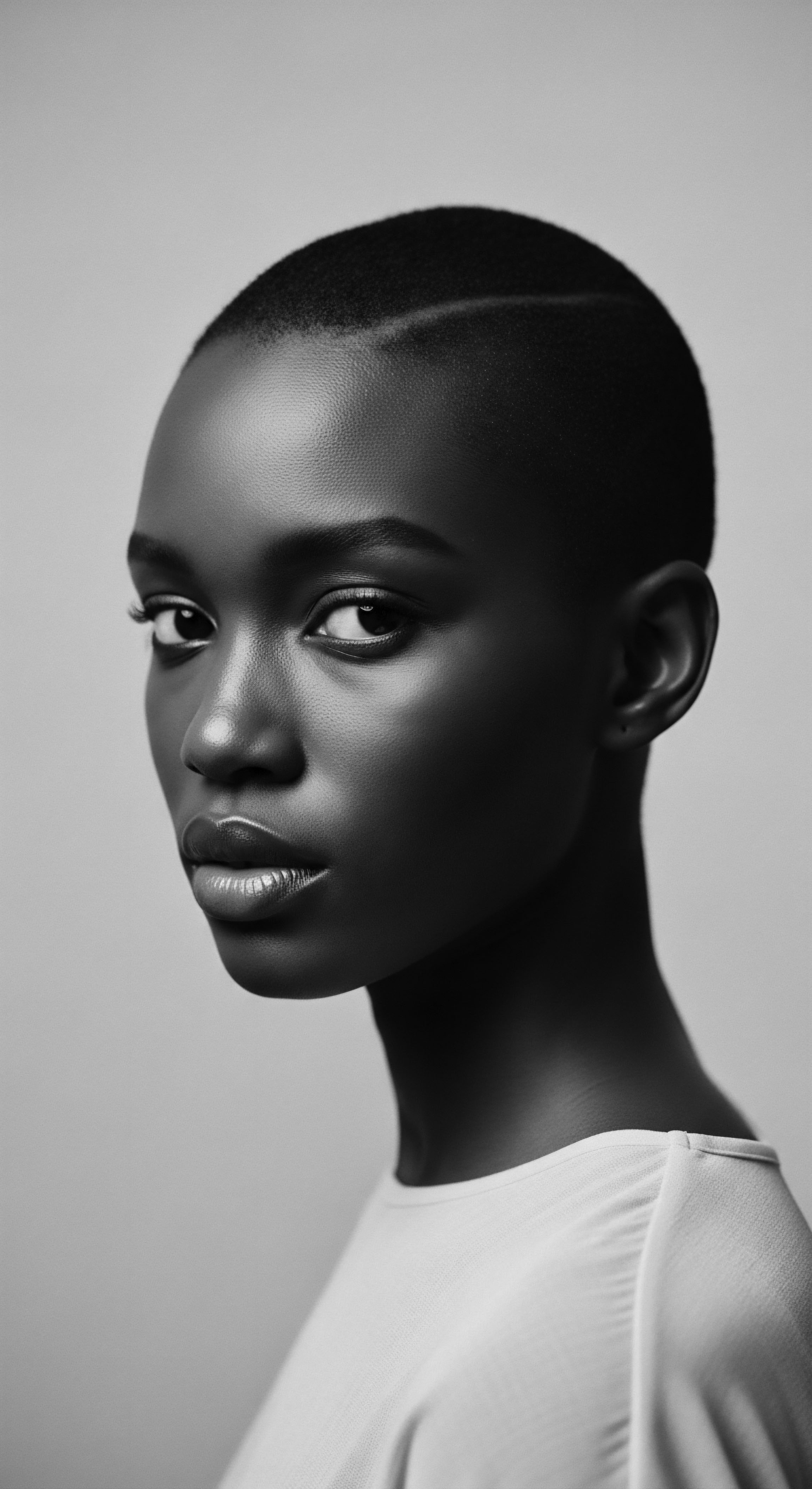
Roots
Consider for a moment the very helix of a strand, not merely as a biological marvel, but as a living scroll, holding generations of whispers, resilience, and wisdom. For those whose hair dances in intricate coils, springs, and waves—hair often called textured—the interaction with its environment is a story told in each gentle brush and every waking hour. This story, steeped in the ancestral plains of our lineage, speaks of protection, preservation, and the enduring quest for radiance.
A quiet, yet powerful, ally in this timeless pursuit has emerged ❉ silk. But why, one might ask, does silk hold a unique significance for the coiled and kinky, the wavy and wonderfully complex strands that have adorned our foremothers and continue to crown our present?
To understand this connection, we must first journey into the very architecture of textured hair. Unlike its straighter counterparts, textured hair possesses an elliptical cross-section, its unique follicular shape causing the hair shaft to twist and turn as it grows. This inherent characteristic, a beautiful testament to diversity, means that at every bend and curve, the cuticle layers—the outermost protective scales of the hair—are lifted and more exposed.
This structural reality renders textured hair inherently more prone to moisture loss and mechanical friction. Every brush against a coarse surface, every restless night on a rough pillowcase, contributes to the delicate cuticle layer being further ruffled, leading to breakage, split ends, and a dulling of its natural luster.

Anatomy of a Crowned Inheritance
The unique helical structure, a signature of many ancestral hair patterns, means our hair strands are not smooth, linear conduits. They are, instead, a series of elegant, microscopic undulations. At each turn of the helix, the hair’s outermost layer, the Cuticle, experiences points of stress. These points are particularly vulnerable to abrasion.
When cotton, a staple of modern bedding, encounters these delicate undulations, its microscopic fibers act like tiny hooks, catching and snagging the raised cuticles. This continuous micro-abrasion strips the hair of its precious moisture, causing it to become dry, brittle, and susceptible to fracture. This biological truth underscores why generations have sought methods to preserve and protect their crowns.

Does Hair’s Ancestral Structure Demand Unique Care?
Indeed, the historical record of textured hair care speaks volumes about this fundamental need for protection. From ancient Kemet to the vibrant communities of West Africa, hair was not simply an accessory; it was a profound symbol of identity, status, spirituality, and tribal affiliation. The elaborate styling and intricate braiding techniques of our ancestors were not merely aesthetic choices. They were often practical strategies to shield hair from the harsh elements, to maintain its health, and to preserve its delicate structure.
These protective styles, requiring meticulous care and often lasting for weeks, inherently understood the fragility of uncovered, exposed hair. The foresight in these practices, born from centuries of observation and adaptation, laid the groundwork for modern understanding of how external factors influence hair’s integrity.
The inherent structure of textured hair, with its unique bends and lifted cuticles, necessitates a gentle touch and protective environment, a wisdom long understood by our forebears.
Consider the ancient traditions of oiling and moisturizing, which were integral to many African hair rituals. These practices served to lubricate the hair shaft, providing a barrier against friction and moisture loss, thereby strengthening the strand against environmental stressors. While the precise material of a head covering might have varied from region to region, driven by availability and cultural significance, the underlying principle of preserving hair from external damage was universal. The smooth, breathable quality of certain plant fibers or finely processed animal skins would have been intuitively preferred for comfort and minimizing snags.
| Ancestral Principle Preservation of Length and Health |
| Traditional Practice/Goal Braiding, twisting, oiling, and wrapping hair to guard against environmental wear. |
| Silk's Modern Alignment for Textured Hair The smooth surface of silk actively reduces friction, preventing mechanical damage and retaining moisture. |
| Ancestral Principle Moisture Retention |
| Traditional Practice/Goal Applying natural oils and butters to lubricate and seal the hair shaft. |
| Silk's Modern Alignment for Textured Hair Silk's non-absorbent properties allow hair to retain natural oils and applied moisturizers, avoiding dryness. |
| Ancestral Principle Identity and Status |
| Traditional Practice/Goal Elaborate head coverings and intricate styles signifying social standing or spiritual connection. |
| Silk's Modern Alignment for Textured Hair Modern silk bonnets and pillowcases extend protective care, honoring hair as a significant part of identity and self-care. |
| Ancestral Principle Ancestral wisdom and modern science converge in silk's beneficial properties for textured hair, reflecting a continuous thread of care. |

Ritual
The care of textured hair has always been, at its heart, a ritual—a series of intentional acts passed down through generations, each movement carrying significance, each ingredient chosen with purpose. This ritual is not confined to the wash day or styling sessions; it extends into the quiet hours of rest, particularly the sacred space of nighttime. For centuries, our ancestors intuitively understood the need for protection, often wrapping their hair in various fabrics to preserve intricate styles, guard against the elements, and signal cultural identity. This ancestral practice of covering the head, deeply ingrained in the heritage of Black and mixed-race communities, finds a potent evolution in the modern use of silk.

The Gentle Embrace of Nighttime Care
Think of the nightly preparation, the gentle coiling of strands, the application of a rich butter or oil, and then the careful covering. This nightly act, for many, is a moment of quiet connection to self, a continuation of practices that speak across time. The transition from simple headwraps of various materials to the deliberate choice of silk for nighttime protection is a subtle yet significant evolution.
While historically materials like cotton, wool, or various plant fibers were used, their primary purpose was often containment or adornment. The contemporary understanding of silk’s unique properties elevates this practice from mere covering to active preservation.
The unique smooth surface of silk, unlike the microscopic barbs of cotton, allows hair to glide over it without snagging. This greatly reduces the mechanical friction that can lead to breakage. For textured hair, where each bend and coil presents a point of vulnerability, minimizing friction is paramount. This makes silk a particularly potent ally in preserving the structural integrity of the hair shaft, especially during sleep when movement is often unconscious and prolonged.

How Does Silk Honor Ancestral Styling Practices?
Consider the legacy of protective styles . From tightly coiled Bantu knots of ancient African civilizations to the intricate cornrows and twists that define contemporary Black hair artistry, these styles are designed to protect the hair from daily manipulation and environmental aggressors. Maintaining these styles for extended periods requires minimizing disruption to the hair shaft. Cotton pillowcases and scarves, despite their softness to the touch, still create microscopic friction.
This friction can lead to frizz, undo definition, and contribute to breakage, thereby undermining the protective intent of the style. Silk, by allowing the hair to slide freely, preserves the integrity of these styles for longer, extending the benefit of the labor and artistry invested in them. This aligns seamlessly with the ancestral desire to maintain healthy, resilient hair.
One powerful historical example highlighting the deep-rooted practice of hair covering and its evolution can be found in the Tignon Laws enacted in colonial Louisiana during the late 18th century (Gould, 1998). These discriminatory laws compelled Black women, particularly those of mixed heritage who often styled their hair elaborately, to cover their heads with a “tignon” or headwrap. The intention was to suppress their perceived attractiveness and social standing. However, these women, with profound strength and ingenuity, transformed the tignon into a powerful statement of style, resistance, and cultural pride, often creating elaborate, colorful, and highly fashionable wraps.
While the material specified was often coarse and intended to humble, the act of covering one’s hair became a profound expression of self and community. The modern adoption of silk for hair protection, particularly at night, can be seen as a continuation of this heritage of deliberate hair covering, but with a renewed sense of empowerment and a scientifically validated benefit for hair health, turning a tool of oppression into one of active self-care and beauty.
Nighttime hair rituals, with their deep ancestral roots in protection and preservation, find their most effective modern expression in the gentle, frictionless embrace of silk.
The application of oils and butters, a practice deeply ingrained in many ancestral hair care traditions, also finds a harmonious partner in silk. Many traditional remedies relied on plant-based emollients, like shea butter or coconut oil, to seal moisture into the hair strand. When applied, these products create a protective layer. Cotton, being a highly absorbent fiber, can wick away these beneficial oils, leaving hair dry and vulnerable.
Silk, on the other hand, is a protein fiber and less absorbent than cotton. It allows the applied moisture and oils to remain on the hair shaft, where they can continue to provide their nourishing benefits. This property of silk means that the care invested in moisturizing and oiling hair during the day, a direct descendant of ancestral practices, is preserved and prolonged into the night.
- Historical Headwear ❉ Headwraps were historically used across diverse African cultures for sun protection, carrying items, spiritual symbolism, and safeguarding elaborate hairstyles, predating modern silk use.
- Oiling Practices ❉ Ancestral knowledge recognized the necessity of applying natural oils and butters to the hair and scalp for lubrication, moisture sealing, and protection from environmental aggressors.
- Protective Styling ❉ Braiding, twisting, and coiling were not just aesthetic but practical methods to minimize daily manipulation, prevent tangling, and maintain hair health over extended periods.
The ritual of hair care for textured strands, from meticulous cleansing to thoughtful styling and deliberate nightly protection, is a living, breathing testament to a heritage of resilience and beauty. Silk, in this context, is more than a luxury; it is a scientifically validated tool that elevates and respects these enduring traditions, bringing ancient wisdom into a present-day context of optimal hair health. The silent act of sliding a silk bonnet over one’s coils before sleep echoes generations of care, a continuous thread woven through the fabric of ancestral memory and contemporary self-love.

Relay
The story of textured hair, its unique biology, and its journey through time is one of remarkable continuity, a living relay race of wisdom passed from hand to hand across generations. The profound understanding of how to care for these magnificent crowns, honed over centuries by Black and mixed-race communities, now intersects with scientific insights, affirming and amplifying ancestral practices. Within this dialogue between the ancient and the modern, silk stands as a compelling testament to the enduring principles of hair preservation. We move beyond surface explanations to consider the deeper physiological and historical rationales.

Why Do Textured Strands Crave a Smooth Surface?
At a microscopic level, the cuticle layers of textured hair—those tiny, overlapping scales that form the outermost protective sheath—are naturally more open and prone to lifting due to the hair shaft’s elliptical shape and multiple bends. This structural characteristic makes textured hair inherently more susceptible to mechanical friction, a relentless antagonist to hair health. When a strand of textured hair rubs against a coarse surface, like a standard cotton pillowcase, the minute fibers of the cotton act like sandpaper, catching and abrading these already vulnerable cuticles. This persistent roughening strips the hair of its lipid layer, its natural protective barrier, leading to ❉
- Increased Porosity ❉ An open cuticle allows moisture to escape more readily, resulting in chronic dryness.
- Tangled Formation ❉ Rough cuticles snag each other, creating knots and tangles that require forceful detangling, further damaging the hair.
- Friction Breakage ❉ The constant rubbing weakens the hair shaft, causing it to snap, leading to reduced length retention.
Silk, by stark contrast, possesses an incredibly smooth protein structure. Its fibers are long and tightly woven, creating a surface where hair can glide with minimal resistance. This drastically reduces the mechanical stress on the cuticle.
The result is hair that remains smoother, retains its moisture, and experiences significantly less breakage. This scientific understanding validates the intuitive pursuit of gentle surfaces that echoes through ancestral practices of wrapping and protecting hair.

Beyond Friction What Moisture Benefits Does Silk Provide?
The moisture balance of textured hair is a central theme in its care. The very structure of coiled and curly hair makes it difficult for natural scalp oils (sebum) to travel down the entire length of the hair shaft. This, combined with the often higher porosity of textured hair, means moisture is both harder to acquire and easier to lose. This foundational biological reality made moisturizing a central tenet of ancestral hair care, often involving various plant-based oils and butters sourced from local flora.
Silk’s unique properties extend to moisture retention in a way that cotton cannot match. Cotton is a hydrophilic fiber, meaning it loves water and readily absorbs moisture from its surroundings, including your hair and any styling products applied to it. This absorption can effectively undo the meticulous moisturizing regimen that is essential for textured hair. Silk, being a protein fiber (primarily fibroin), is significantly less absorbent.
It does not actively draw moisture away from the hair. This means that ❉
- Natural Oils Persist ❉ The hair’s natural oils remain on the strand, providing continuous lubrication and protection.
- Product Efficacy Preserved ❉ Applied conditioners, leave-ins, and moisturizers stay where they are meant to be—on the hair—working their restorative magic overnight.
- Reduced Dryness ❉ By maintaining optimal moisture levels, silk helps to prevent the dryness and brittleness that are precursors to breakage and dullness, honoring the ancestral drive for hair health.
This aspect of silk’s benefit is not a mere convenience; it is a profound alignment with the historical struggle to maintain hair health against environmental and societal pressures that often exacerbated dryness and fragility. The legacy of hair care in the diaspora is one of adaptation and ingenuity, making the most of available resources to nourish and protect. Silk, now more accessible, offers a scientifically proven enhancement to these long-standing traditions.
Silk’s non-absorbent, smooth surface provides a crucial barrier against the environmental stressors that have historically challenged the integrity of textured hair, maintaining its moisture and vitality.
Furthermore, the use of silk extends beyond nightly protection; it becomes an active participant in preserving the effects of styling. Many traditional and modern textured hair styles, such as braids, twists, and locs, rely on specific patterns and textures to achieve their aesthetic and protective qualities. The smooth surface of silk helps to maintain the definition of these styles, preventing the frizzy halo that often forms around the hair shaft when it experiences friction against rough surfaces.
This preservation of style means less manipulation, less re-styling, and ultimately, less stress on the hair over time. It reinforces the ancestral principle of minimizing daily trauma to the hair.

Reflection
The journey through the intricate world of textured hair, from its elemental biology to its profound cultural narratives, consistently brings us back to a central truth ❉ care for these strands is a dialogue with heritage. The unique kinship between textured hair and silk, explored through the lens of ancient wisdom and contemporary understanding, speaks not merely of a practical benefit, but of a deeper reverence. Each coil and wave carries stories of resilience, of beauty forged in adversity, and of an enduring connection to ancestral practices.
When we choose silk, we are not simply selecting a material; we are participating in a long lineage of protection, affirming the value of our crowns, and honoring the legacy of those who meticulously cared for their hair against countless odds. This choice echoes a soul-deep understanding that our strands are more than fibers; they are living archives, deserving of the gentlest touch, a testament to the enduring power of ancestral wisdom.

References
- Gould, Virginia M. 1998. “The Tignon.” In Creole ❉ The History and Legacy of Louisiana’s Free People of Color, edited by Sybil Kein. Baton Rouge ❉ Louisiana State University Press.
- Dabiri, Emma. 2020. Don’t Touch My Hair. London ❉ Penguin Books.
- Bird, Stephanie. 2005. The History of Black Hair. New York ❉ Chelsea House Publishers.
- Roberson, Elizabeth A. 2009. Treasure Your Hair ❉ The Ultimate Guide to Healthy, Natural Textured Hair. New York ❉ HarperCollins.
- Bryer, Sarah. 2011. Hair ❉ A Cultural History. London ❉ Bloomsbury Academic.
